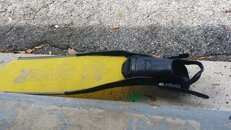Are there any issues with using the long (all types including carbon material) free diving fins while spearfishing on scuba? I was told by one big name manufacturer that there is a bigger chance of these fins break where the blade meets the foot pocket due to the heavy weight of the scuba equipment. This manufacturer even told me that they won't warranty these fins if they break and they suspect that you used them with scuba.
Does it make sense to use them with scuba for spearfishing or one should just continue using the scuba type fins while spearfishing on scuba? What are your thoughts please?
That is a load of dung...Must be from a very low end mfg.
While using a giant stride entry is BAD for many freediving fins, whether freediver or scuba diver..due to over flexing the blade..the composite fins are practically indestructible, fins like the Lamborghini Gallardos of freedive fins, the Dive R freedive fins....which can be used with the Riffe Silent Hunter open heel foot pocket, allowing a scuba diver to use a traditional bootie ( though thin sole is better than thick sole for this). **Best way to enter water with freedive fins, is step out and twist mid air to a back flop..very easy to do......let the fins hit heel first, and you don't overflex the blade.
As to the actual swimming with fins, any good freedive fin will be massively superior to all scuba fins for efficiency and power, whether going slow, medium pace or fast...and of course a spearfishing pace is normally fast, and the freedive fin wearing divers are often 2 and three times faster than scuba fin wearing divers--and they do so without apparent effort....they cover more ground, find more structure big fish can be hanging out near, and this makes for more effective hunting than being the "leaf blown in the wind" like the typical scuba diver with junk fins like mares quatros, splits, jets, or complete nonsense like the Seawings...
The only places freedive fins will not be massively superior to traditional scuba fins, is in cave, or in technical wreck penetrations, where the fin tips might brush the ceiling and cause silt. Frog kicking is amazing with Dive R freedive fins...a huge push, and a 10 foot glide.
Walking on the charter boat is slightly more coordination intensive, but if you are a decently coordinated person, this is entirely a non-issue.





